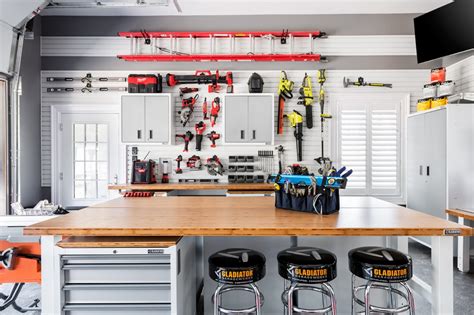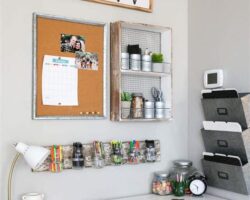Are you tired of working on your DIY projects in a cluttered and disorganized space? Have you been dreaming of setting up your very own workshop in your garage? Look no further, because in this blog post, we will be sharing valuable tips and tricks on how to create an efficient and well-organized workshop in your garage. From maximizing space and choosing the right tools to ensuring safety and creating a functional layout, we’ve got you covered. We’ll also delve into DIY solutions for building workbenches, creative ideas for workshop organization, and options for heating, cooling, and ventilation to enhance comfort. Whether you’re a woodworking enthusiast, a mechanic, or a hobbyist looking to take your projects to the next level, this post will provide you with the essential guidance to transform your garage into the workshop of your dreams. Stay tuned for practical advice and actionable insights that will help you unleash your creativity in a space that truly inspires.
Maximizing Space: Organizing Your Garage Efficiently
Maximizing space in your garage is essential for creating an efficient and functional workspace. By organizing your garage in a strategic way, you can make the most of the available space and create a clutter-free environment for your DIY projects.
One of the first steps in maximizing space in your garage is to declutter and get rid of any items that you no longer need. This will free up valuable space and make it easier to keep your garage organized in the long run. Consider donating or selling items that are in good condition or recycling those that are no longer usable.
Investing in storage solutions, such as shelving, cabinets, and overhead racks, can also help you make the most of the vertical space in your garage. By utilizing the walls and ceiling for storage, you can free up valuable floor space for your tools and workspace. Additionally, using clear storage bins can help you easily identify and access your tools and equipment.
Lastly, consider implementing a labeling system for your storage containers and shelves to ensure that everything has a designated place. This will not only help you stay organized but also make it easier to find and put away your tools and supplies.
Choosing the Right Tools: Essential Equipment for Your Workshop
When it comes to setting up a workshop, the tools you choose can make a big difference in the efficiency and success of your projects. Essential equipment for your workshop should include a variety of hand tools, power tools, measuring and layout tools, as well as safety equipment to ensure a secure and well-equipped workspace.
Hand tools such as hammers, screwdrivers, pliers, and wrenches are necessary for a variety of tasks. Investing in high-quality, durable tools will save you time and frustration in the long run. Power tools such as drills, saws, sanders, and routers can speed up tasks and make them more precise, but it’s important to choose the right tools for your specific needs and projects.
Measuring and layout tools, including tape measures, levels, squares, and marking tools, are crucial for accurate and precise work. Having the right measuring tools can make the difference between a well-built project and a sloppy one. Safety equipment such as goggles, ear protection, gloves, and dust masks should never be overlooked. Protecting yourself from potential hazards is essential for a successful workshop.
By choosing the right tools and equipment for your workshop, you can ensure that your projects are completed efficiently, accurately, and safely. Take the time to research and invest in high-quality tools that will last for years to come.
Safety First: Setting Up a Secure and Well-lit Workshop
When it comes to setting up a secure and well-lit workshop, the safety of yourself and those around you should always be the top priority. One of the first steps in ensuring a safe workshop is to have proper lighting. Well-lit work areas are essential for preventing accidents and injuries, so invest in bright overhead lights and task lighting for specific areas such as workbenches and machinery.
Another important aspect of workshop safety is maintaining a clutter-free and organized space. Keep walkways clear of tools and materials, and designate specific areas for storing equipment. This will not only reduce the risk of tripping and falling, but it will also make it easier to find what you need, when you need it.
It’s also crucial to have a first aid kit and fire extinguisher readily available in the workshop. Accidents can happen, and being prepared with the right supplies can make a big difference in the outcome. Additionally, consider investing in safety equipment such as protective eyewear, ear protection, and dust masks to minimize the risk of injury from flying debris or harmful substances.
Lastly, take the time to educate yourself and others who will be using the workshop on safe working practices and proper tool usage. Knowledge is power when it comes to preventing accidents, so don’t overlook the importance of training and awareness.
Creating a Functional Layout: Designing Your Workshop Space
When designing your workshop space, it’s important to consider the functionality of the layout. Maximizing the use of the available space is crucial in order to create a productive and efficient working environment. You want to ensure that there is enough room for all of your essential tools and equipment, as well as space to move around comfortably.
One key aspect of designing a functional layout is to choose the right storage solutions. Utilizing wall-mounted shelving, pegboards, and storage cabinets can help keep your workshop organized and clutter-free. This not only creates a more pleasant working environment, but also allows for easy access to your tools and materials.
Another important consideration when designing your workshop space is ensuring that there is adequate lighting. Proper lighting is essential for safety and productivity. Utilizing task lighting, overhead lighting, and natural light sources can help create a well-lit and comfortable workspace.
Lastly, it’s important to consider the flow of your workspace. You want to arrange your tools and workbenches in a way that makes sense for the type of projects you’ll be working on. Creating designated areas for specific tasks or tools can help streamline your workflow and improve efficiency.
Building Workbenches: DIY Solutions for Your Garage
When it comes to setting up your garage workshop, one of the most important elements to consider is the workbench. A sturdy and functional workbench is essential for any DIY project, providing a stable and reliable surface for a variety of tasks.
Building your own workbench can be a cost-effective and rewarding DIY project. By customizing the size and features to your specific needs, you can create a workbench that perfectly suits your workshop space.
One popular DIY solution for building workbenches is using basic lumber and plywood. This allows for easy customization and provides a durable and reliable work surface. Additionally, adding shelves or drawers to your workbench can help keep your tools and materials organized and easily accessible.
Another option for DIY workbenches is using repurposed materials, such as old doors or industrial pallets. This not only helps reduce waste but also adds a unique and rustic touch to your workshop. Whichever method you choose, building your own workbench allows you to create a functional and personalized workspace for all your projects.
Optimizing Storage: Creative Ideas for Workshop Organization
When it comes to creating a well-functioning workshop, organization is key. Having a cluttered and disorganized space can make it difficult to find tools and supplies, as well as create safety hazards. By optimizing storage in your workshop, you can create a more efficient and productive workspace.
One creative idea for workshop organization is to utilize vertical storage. Installing pegboards or slat walls can provide a place to hang tools and keep them within easy reach. This not only helps to free up valuable floor space, but also makes it easier to find and access the tools you need.
Another storage solution is to use stackable storage bins or drawers. These can be used to store smaller items such as screws, nails, and other hardware. Labeling the bins or drawers can help to keep everything organized and easily accessible, saving you time and frustration when searching for specific items.
Additionally, utilizing overhead storage can help to maximize the use of space in your workshop. Hanging shelves or ceiling-mounted racks can be used to store items that are not frequently accessed, such as seasonal supplies or bulky equipment.
Enhancing Comfort: Heating, Cooling, and Ventilation Options for Your Garage Workshop
When it comes to creating a comfortable and functional workspace in your garage, heating, cooling, and ventilation are key considerations. Whether you use your garage as a workshop for DIY projects, car repairs, or as a hobby space, having the right climate control options can make a huge difference in your overall experience.
One of the most popular heating options for a garage workshop is a space heater. These portable units are usually powered by electricity or propane and can quickly warm up your workspace, allowing you to comfortably work on your projects even during the colder months.
Similarly, cooling options such as fans or portable air conditioning units can help keep your garage workshop comfortable during the summer months. Proper ventilation is also crucial for removing fumes and ensuring clean air circulation, especially if you work with paints, chemicals, or other potentially hazardous materials.
Ultimately, the key to enhancing comfort in your garage workshop lies in choosing the right combination of heating, cooling, and ventilation options that best suit your needs and workspace layout. By prioritizing your comfort and safety, you can create an environment that allows you to fully focus on your projects without being hindered by extreme temperatures or poor air quality.





